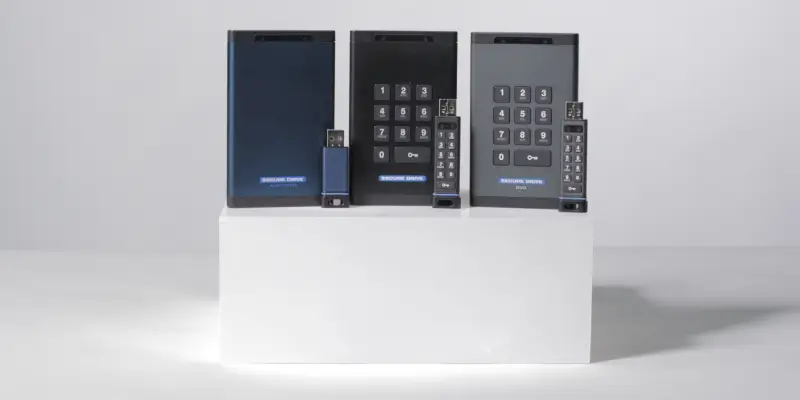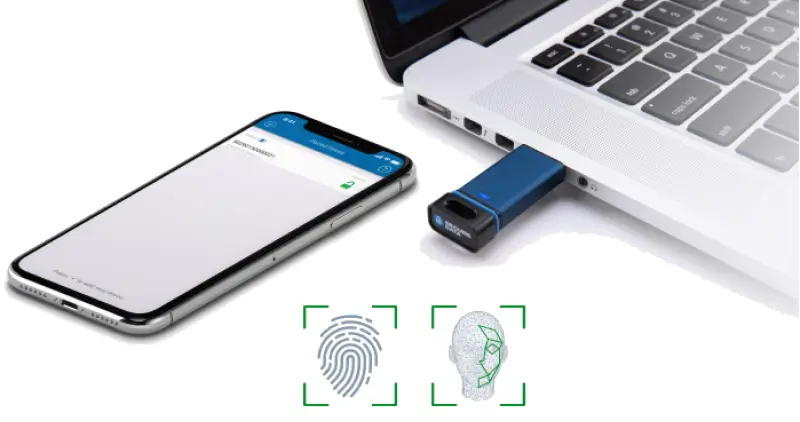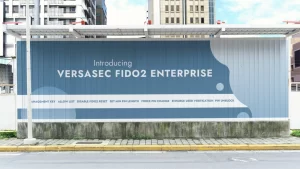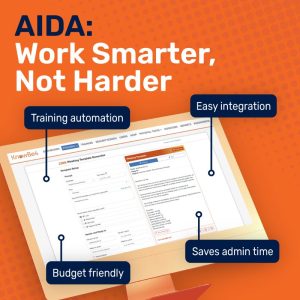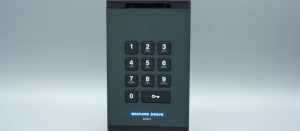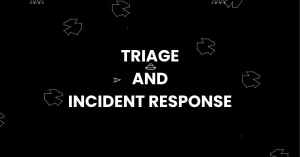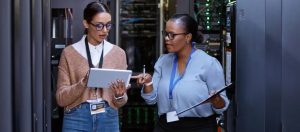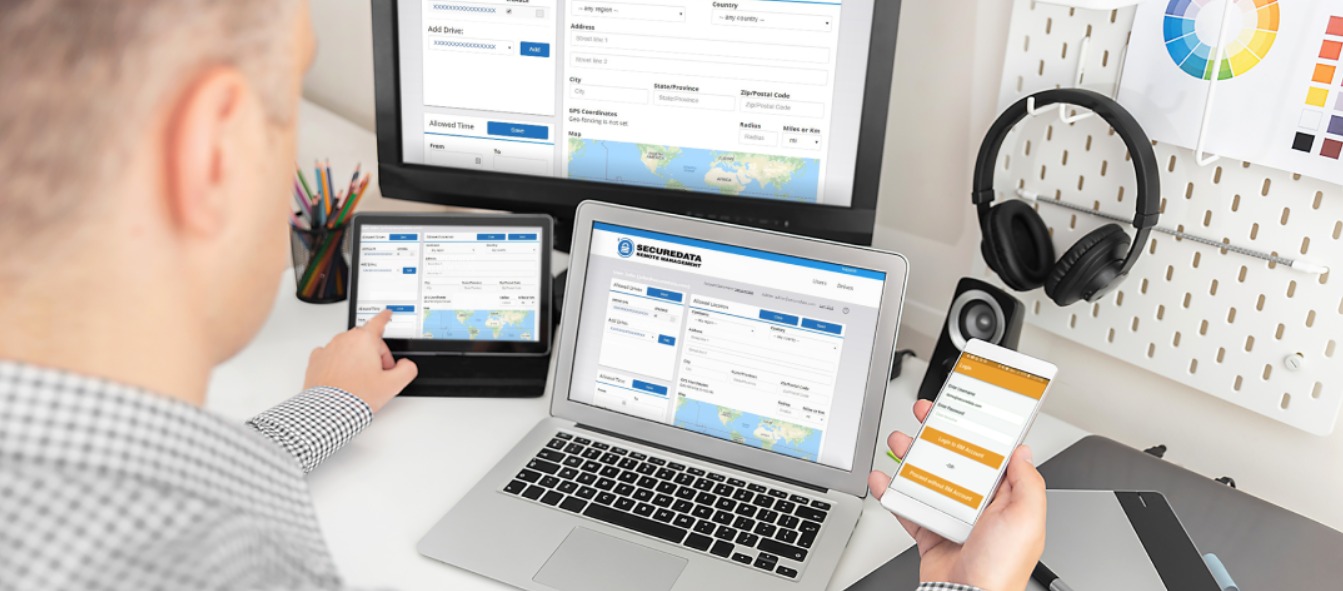
Các vụ rò rỉ dữ liệu đang ngày càng trở nên phổ biến, với các nghiên cứu gần đây cho thấy trong năm 2024, hơn 16,8 tỷ bản ghi đã bị lộ do các sự cố dữ liệu. Con số này tương đương với khoảng 533 bản ghi bị xâm phạm mỗi giây suốt cả năm. Thống kê đáng báo động này nhấn mạnh nhu cầu cấp thiết về giải pháp mã hóa dữ liệu mạnh mẽ và các phương thức quản lý hiệu quả. Ổ đĩa mã hóa là những thiết bị lưu trữ được trang bị các thuật toán mã hóa tiên tiến, đóng vai trò quan trọng trong việc bảo vệ thông tin nhạy cảm khỏi truy cập trái phép. Công nghệ quản lý từ xa cho phép người dùng quản trị các ổ đĩa mã hóa này một cách an toàn từ mọi vị trí, mang lại mức độ tiện lợi vượt trội.
Các chuyên gia tại SecureData giải thích cách mà quản lý từ xa mang lại sự tiện lợi mà không phải hy sinh tính bảo mật của các ổ đĩa mã hóa.
Quản lý từ xa là gì?
Remote management refers to the capability of accessing and controlling encrypted drives securely from any geographic location through a network connection. At its core, remote management technology involves specialized software tools that authenticate authorized administrators or users, allowing them to configure, monitor, and troubleshoot encrypted external drives and USB flash drives without physical access. Authentication typically involves powerful identity verification methods such as multi-factor authentication (MFA) and secure communication protocols to ensure data privacy and integrity.
Quản lý từ xa đề cập đến khả năng truy cập và điều khiển các ổ đĩa mã hóa một cách an toàn từ bất kỳ vị trí địa lý nào thông qua kết nối mạng. Về cơ bản, công nghệ quản lý từ xa bao gồm các công cụ phần mềm chuyên dụng giúp xác thực các quản trị viên hoặc người dùng được ủy quyền, cho phép họ cấu hình, giám sát và khắc phục sự cố ổ đĩa ngoài mã hóa và USB flash drive mà không cần tiếp xúc vật lý.
Việc xác thực thường sử dụng các phương pháp xác minh danh tính mạnh mẽ như xác thực đa yếu tố (MFA) và các giao thức truyền thông an toàn để đảm bảo quyền riêng tư và tính toàn vẹn của dữ liệu.
Encryption standards, such as AES-256 (Advanced Encryption Standard with a 256-bit key length), provide a strong foundational security layer, ensuring that sensitive data remains inaccessible to unauthorized individuals. When managing encrypted drives remotely, encryption safeguards data transmitted across potentially insecure networks, significantly reducing the risk of interception or unauthorized access.
Convenience of Remote Management for Encrypted Drives
Integrating remote management technology into encrypted drive solutions significantly enhances operational convenience for individuals and organizations. One primary benefit is the ability to manage multiple encrypted drives simultaneously from a centralized interface, streamlining administrative tasks and reducing the complexity traditionally associated with data security.
For example, businesses can remotely update firmware, adjust encryption settings, perform diagnostics, or even initiate secure data erasure without physical intervention. This capability reduces downtime considerably, as issues can be addressed rapidly, avoiding delays caused by manual, on-site procedures.
Furthermore, remote management of encrypted drives provides essential flexibility, especially for geographically dispersed teams or remote workforces. Administrators gain secure, anytime-access to critical systems, regardless of their physical location, enhancing productivity and efficiency across organizational workflows.
Remote Management for Individual Users
While remote management technology is commonly associated with enterprise environments, individual users also benefit considerably from its capabilities. Freelancers, remote professionals, and individuals who manage sensitive personal information can use remotely managed encrypted drives to maintain high data security standards without sacrificing convenience.
For instance, individuals traveling frequently or working remotely from various locations can securely access and manage their encrypted drives from anywhere without the risk associated with physically carrying sensitive data. Remote wipe capabilities further protect individuals by enabling swift data deletion if a device is lost or stolen.
Balancing Convenience and Security
While remote management of encrypted drives offers significant convenience, it inherently introduces potential security vulnerabilities. To address these risks, modern remote management systems employ advanced security measures explicitly designed to mitigate vulnerabilities:
Multi-Factor Authentication (MFA)
- Requires multiple forms of verification before granting access.
- Ensures only authorized individuals can manage encrypted drives.
- Dramatically reduces risks from credential theft or unauthorized access attempts.
Zero-Trust Architecture
- Enforces strict verification for every access request, regardless of network origin.
- Eliminates implicit trust, providing protection even from internal threats.
- Enhances security posture through continuous validation of users and devices.
Secure Communication Channels
- Utilizes end-to-end encrypted VPNs and SSL/TLS protocols.
- Ensures confidentiality and integrity of data transmitted during remote management operations.
- Protects against interception, man-in-the-middle attacks, and tampering.
Granular Access Controls
- Enables precise user-permission settings based on roles and responsibilities.
- Limits exposure to sensitive drive functions or data only to essential personnel.
- Reduces potential insider threats and accidental data breaches.
Geo-Fencing and Time-Fencing Capabilities
- Restricts encrypted drive access to specific geographic regions or timeframes.
- Prevents unauthorized use from unfamiliar locations or at unauthorized times.
- Adds another layer of security, enhancing control over when and where drives are accessed.
Comprehensive Audit Logs
- Records detailed activity logs of all remote management operations.
- Facilitates transparency and compliance with industry regulations.
- Enables quick identification and investigation of security incidents or unusual activities.
Technical Insights and Best Practices
Here are some of the features and best practices for Remote Management:
1. Centralized Key Management
- Secure key generation and distribution
- Protected key storage
- Regular key rotation
- Secure disposal after use
2. Remote Wipe Capabilities
- Enable secure, immediate data erasure for drives that become lost, stolen, or compromised.
- Prevent unauthorized access and minimize data leakage risks.
3. Detailed Audit Trails
- Maintain comprehensive logs recording all remote management activities.
- Provide transparency, support forensic analysis, and ensure regulatory compliance.
4. Secure Remote Firmware Updates
- Regularly implement secure firmware updates remotely to patch vulnerabilities.
- Ensure encrypted drives remain resilient against new threats and exploits.
5. Routine Security Assessments
- Conduct periodic assessments of remote management systems and configurations.
- Access permissions and roles
- Authentication and authorization policies
- Security logs and incident reports
6. Continuous Administrator Training
- Provide ongoing training for administrators on emerging threats, tools, and security best practices.
- Foster a proactive, informed security culture to strengthen organizational defense.
SecureData’s Commitment to Convenience and Security
Remote management of encrypted drives effectively bridges the gap between operational convenience and stringent data security. By adopting advanced technical practices and emphasizing robust encryption protocols, businesses and individual users can confidently protect their most sensitive information without compromising ease-of-use or productivity.
SecureData provides industry-leading remote management solutions for encrypted drives, expertly balancing convenience with unmatched security standards. Contact us to speak with a specialist and discuss your needs.
About DT Asia
DT Asia began in 2007 with a clear mission to build the market entry for various pioneering IT security solutions from the US, Europe and Israel.
Today, DT Asia is a regional, value-added distributor of cybersecurity solutions providing cutting-edge technologies to key government organisations and top private sector clients including global banks and Fortune 500 companies. We have offices and partners around the Asia Pacific to better understand the markets and deliver localised solutions.
How we help
If you need to know more about Benefits of SecureData Remote Management, you’re in the right place, we’re here to help! DTA is Secure Data’s distributor, especially in Singapore and Asia, our technicians have deep experience on the product and relevant technologies you can always trust, we provide this product’s turnkey solutions, including consultation, deployment, and maintenance service.
Click here and here and here to know more: https://dtasiagroup.com/secure-data/

